Last updated: July 4, 2020
Article
Ethnobotany of Fruit Trees
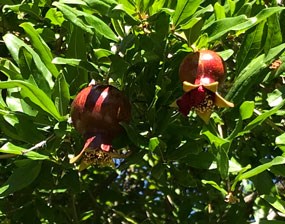
Pomegranate (fruit-bearing)
Punica granatum, Family: PunicaceaOrigin: Central Asia and Iran (formerly Persia)
Historical culinary uses: Arab traders, and subsequently Spanish explorers, used pomegranate juice as a beverage on long trips across arid lands. A pomegranate can be up to 80% water, and its juice replenished the minerals lost during perspiration. The juice was also used in cooking sauces, fermented into a wine, and processed into jelly.
Historical medicinal uses: Pomegranate juice was used by the Greeks and Romans as a general cure-all. The fruit rind and tree bark were a remedy for diarrhea and stomach problems. The seeds and juice were considered a tonic for the heart. Currently, the antioxidant properties of the fruit are being studied as treatment for and prevention of cancer, cardiovascular disease, and diabetes.
Interesting facts: References to the pomegranate are found in Christian, Islamic, and Jewish religious manuscripts, and in ancient Hindu and Chinese medicine systems. The first record of pomegranate cultivation appears in 2200 B.C. near the Tigris and Euphrates Valleys in what is now Basra, Iraq.
Found in Tumacácori: courtyard garden, heritage orchard, near tortilla ramada

Pomegranate (ornamental)
Punica granatum, Family: PunicaceaOrigin: Central Asia and Iran (formerly Persia)
Historical culinary uses: None; ornamental varieties bear either no fruit or small inedible fruit.
Historical medicinal uses: The tree’s bark may have used for the same medicinal reasons as the fruiting varieties, but ornamental varieties were primarily grown for their showy double flowers.
Interesting facts: Many ornamental varieties grow only to three or four feet tall and have been hybridized in Japan for use as bonsai specimens.
Found in Tumacácori: courtyard garden, museum patio
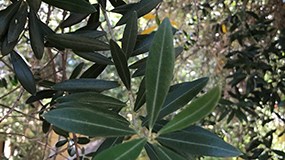
Olive
Olea europaea, Family: OleaceaeOrigin: Mediterranean Region, Western Asia
Historical culinary uses: Olives and olive oil were the main ingredients in Mediterranean cooking. The oil was used for cooking and also lighting, and in religious ceremonies. About 90% of harvested olives were turned into oil. The remaining 10% were eaten green or black as table olives.
Historical medicinal uses: Olive leaves were used in the Mediterranean region for thousands of years to reduce fever, fight infection, speed wound healing, heal rashes, and cleanse the liver. They were also considered a remedy for high blood pressure, high blood sugar, and anxiety. Olive oil was used on the body and in the hair for grooming and good health.
Interesting facts: Olive trees can live to a great age. There is a tree in Algave, Portugal that is 2,000 years old according to radio carbon dating. In 1560 the first seedlings from Spain were planted in Lima, Peru by Antonio de Rivera. In about 1769 the first olive trees were cultivated at Mission San Diego Alcala.
Found in Tumacácori: courtyard garden

Apricot
Prunus armeniaca, Family: RosaceaeOrigin: China? (origin disputed)
Historical culinary uses: Eaten fresh, dried or cooked. The kernels inside the pits of apricots from central Asia and the Mediterranean are so sweet that they are frequently substituted for almonds. The liqueur amaretto is flavored with extract of apricot kernels rather than almonds.
Historical medicinal uses: Cyanogenic glycosides are found in the seeds, bark, and leaves of apricots. In England in the 17th century apricot oil was used to heal tumors, swellings, and ulcers. Apricots were considered an aphrodisiac in the time of Shakespeare, and were mentioned as such in “A Midsummer Night’s Dream.”
Interesting facts: Apricot kernels contain between 2.05% and 2.40% hydrogen cyanide, but normal consumption of apricots is insufficient and unlikely to produce any serious effects. The origin of the apricot is controversial. Some sources attribute them to India in about 3000 BC; other sources suggest China, Persia, Japan, Armenia, and the Caucasus.
Found in Tumacácori: courtyard garden, heritage orchard
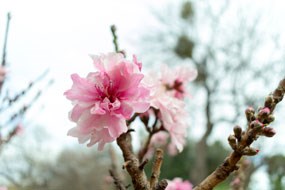
Miniature Bonanza Peach (not heritage variety)
Prunus persica, Family: RosaceaeOrigin: Genetic studies suggest peaches originated in China.
Historical culinary uses: Eaten fresh, dried, or cooked.
Historical medicinal uses: Albertus Magnus in his 1517 essay “De Vegetabilibus et Plantis,” in his book Parra Naturalia, wrote that peaches were an aphrodisiac for men whose passion was waning. This belief was common in Europe for centuries.
Interesting facts: In the 1990s, Tumacácori preservation specialist David Yubeta was doing conservation work on the ruins. An adobe brick broke in half and there, in the middle of the brick, were peach pits. This interesting revelation helped to inspire the eventual planting of the Tumacácori heritage orchard. (This miniature peach is not a heritage variety.)
Peach trees still grew along the flowing mission acequia (irrigation ditch) into the 1940s. Wives of early park superintendents made jam with the fruit.
Found in Tumacácori: courtyard garden
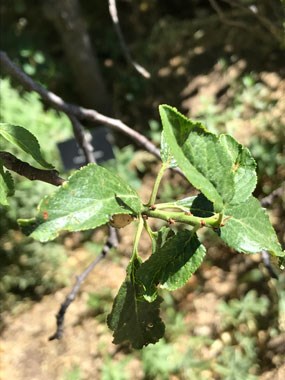
Plum
Prunus x domestica, Family: RosaceaeOrigin: Western Asia and Caucasus mountains (Russia, Georgia, Azerbaijan, and Armenia)
Historical culinary uses: Eaten fresh, dried, or cooked. The damson plum was introduced into North America by English settlers in the northeast and by the Spanish in the southwest. Most often used for cooking and making preserves, the fruit was usually served with braised and roasted meats and fowl. Distillation of the fruit made a wine similar to port, also a type of gin, and distilled plum spirits.
Historical medicinal uses: The aromatic resin from tree trunk wounds was used medicinally. Bark extracts were thought to reduce some forms of inflammation.
Interesting facts: The plum was thought to have been brought to Britain and Europe by the Romans. It was a favorite tree of both the English and Spanish settlers and today can be found growing wild in many states. As with other pitted, or “stone” fruits (apricots, cherries, peaches, pears, plums and prunes), the kernels within the pits contain small amounts of cyanide.
Found in Tumacácori: courtyard garden, heritage orchard
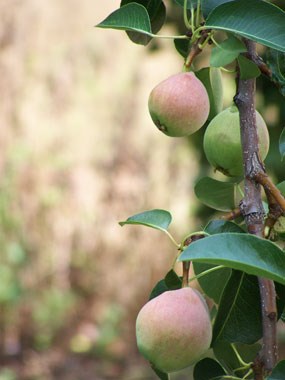
Pear
Pyrus communis, Family: RosaceaeOrigin: Asia
Historical culinary uses: Eaten fresh, dried, cooked into jams, compotes, pies and cakes.
Historical medicinal uses: The fruit was considered an excellent source of fiber and was used in the treatment of constipation and intestinal inflammation. Pear extract was said to cure cystitis and kidney stones.
Interesting facts: Pears have been found in Neolithic and Bronze Age archeological sites in Europe. In 50 BC the Romans knew of forty pear cultivars; by the 1600s there were almost 1,600 cultivars.
Found in Tumacácori: courtyard garden, heritage orchard
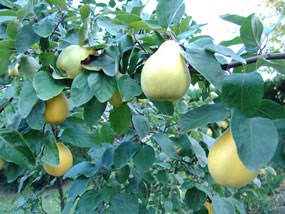
Quince
Cydonia oblonga, Family: RosaceaeOrigin: Iran (formerly Persia), Turkey, and possibly Greece
Historical culinary uses: Quince has a high pectin content and was prepared in many Old World countries as a jam or marmalade. Hispanic countries in the New World still produce a reddish paste called dulce de membrillo that is often eaten with manchego cheese.
Historical medicinal uses: As early as the Roman Empire, quince was used to aid digestion. A gel produce by boiling the seeds was used to treat sore throats and skin rashes.
Interesting facts: Some ancient texts identify Eve’s fruit of temptation as the quince. In ancient Greece, a quince was given as a ritual offering at weddings.
Found in Tumacácori: courtyard garden, heritage orchard
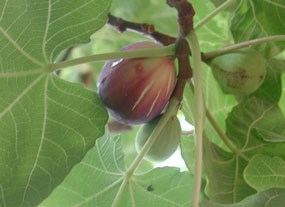
Fig
Ficus carica v. Black Mission, Family: MoraceaeOrigin: Mediterranean
Historical culinary uses: The fig is one of the first plants domesticated by man; it cultivation predates wheat. Remnants of figs have been found in archeological diggings that date from 5,000 B.C. Figs were eaten fresh, dried, or made into a jam.
Interesting facts: Two crops of fruit are produced each year. The first, the breba crop, comes in the spring on the previous year’s shoots. The main crop, which is larger and has better fruit, ripens in the fall on the current year’s shoots.
Found in Tumacácori: courtyard garden, heritage orchard
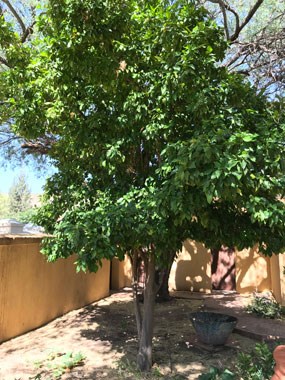
Sour Orange
Citrus aurantium, Family: RutaceaeOrigin: Southeastern Asia
Historical culinary uses: The sour or Seville orange was used to make marmalade, because it has more pectin (a thickening agent) than the sweet orange. While the fresh fruit was not eaten due to its acidity, the juice was valued as a marinade for fish and meat.
Historical medicinal uses: A tea from the leaves was used for a stomach tonic. The aromatic flowers were used in potpourri for their calming effect.
Interesting facts: The white, inner wood is used for woodworking and joinery in Mexico, and in Cuba to make baseball bats.
Found in Tumacácori: courtyard garden
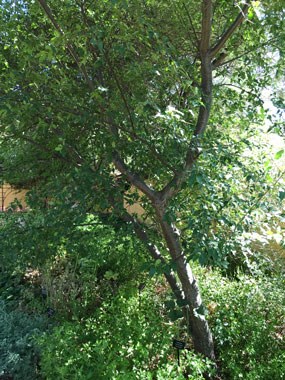
Chokecherry
Prunus serotina, Family: RosaceaeOrigin: North American
Historical culinary uses: Chokecherries were among the most important berries for Native Americans. They were eaten dried, cooked or as an addition to stews. All parts of the cherry except for the flesh of the fruit contain poisonous hydrocyanic acid, which is destroyed by cooking or drying .
Historical medical uses: Native Americans used the berry juice to treat colds, coughs, sore throats and fevers. A tea was made from the bark and leaves and used as a blood tonic, sedative and pain reliever. It was used in sweat lodges as a cure for bile indigestion and jaundice.
Interesting facts: The wood has been used for many years in furniture making because of its luster and dark red tint.
Found in Tumacácori: courtyard garden
